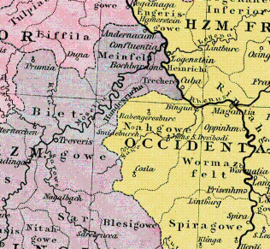Overview
The Wormsgau covered large parts of the present-day Rhenish Hesse and Palatinate regions, originally stretching northwards just before Coblenz in Lotharingia. The city of Mainz belonged likewise to it as, to the start of the 9th century, also Boppard, which in reality c. 825 was already lost again. In the 10th century, the Wormsgau lost extended lands in the North, mostly to the benefit of the Nahegau, like Ingelheim in 937, Spiesheim in 960, Saulheim in 973 and Flonheim in 996, until the Selz river defined the northern border. The losses could be partially compensated through expansion up the Rhine and to the West, especially in the Palatinate Forest range.
This page is based on this
Wikipedia article Text is available under the
CC BY-SA 4.0 license; additional terms may apply.
Images, videos and audio are available under their respective licenses.
